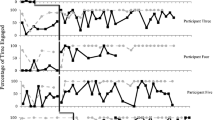Abstract
Daniel Tiger’s Neighborhood is a children’s television show incorporating many elements of video modeling, an intervention that can teach skills to children with autism spectrum disorders (ASD). This study evaluated the impact of watching Daniel Tiger’s Neighborhood episodes on the accurate performance of trying new foods and stopping play politely with two five-year-old children with ASD. Both children showed improved performance of skills only following exposure to episodes of Daniel Tiger’s Neighborhood, suggesting that watching episodes can help children with ASD learn specific skills.

Similar content being viewed by others
References
Anderson, D. R., Lorch, E. P., Field, D. E., & Sanders, J. (1981). The effects of TV program comprehensibility on preschool children's visual attention to television. Child Development, 52, 151–157.
Ayres, K. M., & Langone, J. (2005). Intervention and instruction with video for students with autism: a review of the literature. Education and Training in Developmental Disabilities, 40, 183–196.
Brazelton, T. B., & Greenspan, S. I. (2006). Why children need ongoing nurturing relationships. Early Childhood Today, 21(1), 14–15.
Corbett, B. A., & Abdullah, M. (2005). Video modeling: why does it work for children with autism? Journal of Early and Intensive Behavior Intervention, 2(1), 2–6.
Kalliopuska, M., & Ruokonen, L. (1986). Effects of music education on development of holistic empathy. Perceptual and Motor Skills, 62(1), 187–191.
Lauricella, A. R., Gola, A. H., & Calvert, S. L. (2011). Toddlers’ learning from socially meaningful video characters. Media Psychology, 14(2), 216–232.
Odom, S. L., Boyd, B. A., Hall, J. J., & Hume, K. (2010). Evaluation of comprehensive treatment models for individuals with autism spectrum disorders. Journal of Autism and Developmental Disabilities, 40(4), 425–436.
Schmitt, K. L., Anderson, D. R., & Collins, P. A. (1999). Form and content: looking at visual features of television. Developmental Psychology, 35(4), 1156.
Shukla-Mehta, S., Miller, T., & Callahan, K. J. (2009). Evaluating the effectiveness of video instruction on social and communication skills training for children with autism spectrum disorders: a review of the literature. Focus on Autism and Other Developmental Disabilities, 25, 1–14.
Wartella, E. A., Lee, J. H., & Caplovitz, A. G. (2012). Children and interactive media: research compendium update. Austin, TX: The Markle Foundation.
Author information
Authors and Affiliations
Corresponding author
Ethics declarations
Funding
This study was not externally funded.
Conflict of Interest
The authors declare that they have no conflict of interest.
Ethical Approval
All procedures performed in studies involving human participants were in accordance with the ethical standards of the institutional and/or national research committee and with the 1964 Helsinki declaration and its later amendments or comparable ethical standards.
Informed Consent
Informed consent was obtained from the legal guardians of all individual participants included in the study.
Additional information
Utility of the Work for Clinicians
• Daniel Tiger’s Neighborhood episodes teach relevant skills for children with ASD using elements of video modeling.
• Watching episodes led to increased rates of accurate performance of trying new foods and stopping play politely in children with ASD
• Daniel Tiger’s Neighborhood is a potentially salient and easily accessed resource to supplement instruction for children with ASD
Rights and permissions
About this article
Cite this article
Dotson, W.H., Rasmussen, E.E., Shafer, A. et al. Evaluating the Ability of the PBS Children’s Show Daniel Tiger’s Neighborhood to Teach Skills to Two Young Children with Autism Spectrum Disorder. Behav Analysis Practice 10, 67–71 (2017). https://doi.org/10.1007/s40617-016-0134-z
Published:
Issue Date:
DOI: https://doi.org/10.1007/s40617-016-0134-z




